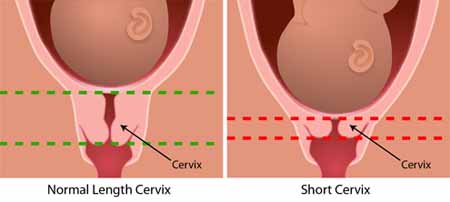NIH study finds progesterone benefits women with short cervix
A National Institutes of Health study has found that progesterone, a naturally occurring hormone, reduced the rate of preterm birth before the 33rd week of pregnancy by 45 percent among one category of at risk women.
The women in the study had a short cervix, which is known to increase the risk for preterm birth. The cervix is the part of the uterus that opens and shortens during labor.

The study also found that infants born to women who had received progesterone were less likely to develop respiratory distress syndrome, a breathing complication occurring in preterm infants.
The study was published online in Ultrasound in Obstetrics and Gynecology.
Infants born preterm are at high risk of early death and long term health and developmental problems. In 2005, there were 12.9 million preterm births worldwide. In the United States, 12.3 percent of infants were born preterm in 2008. Preterm infants are at increased risk for death in the first year of life, and breathing difficulties, cerebral palsy, learning disabilities, blindness and deafness.
The study was undertaken by physicians of the Perinatology Research Branch at NIH’s Eunice Kennedy Shriver National Institute of Child Health and Human Development (NICHD) along with 44 medical centers around the world (including Asia, Africa, Europe, North and South America). The study was a collaboration between the NIH and Columbia Laboratories, Inc., in Livingston, N.J.
“Our study demonstrates that progesterone gel reduces the rate of early preterm delivery—less than 33 weeks— in women with a short cervix,” said Roberto Romero, M.D., program head for Perinatology Research and Obstetrics and chief of the Perinatology Research Branch. “Women with a short cervix can be identified through routine ultrasound screening. Once identified, they could be offered treatment with progesterone.”
Dr. Romero explained that progesterone is a naturally occurring hormone which is essential to maintain pregnancy and that a short cervix is thought to be a sign of a possible shortage of progesterone.
The study authors reasoned that by giving progesterone to women with a short cervix, they could, in many cases, prolong pregnancy.
A total of 458 women with a short cervix (10-20 millimeters) were randomly assigned to receive either a vaginal gel progesterone preparation or a placebo between the 19th and 23rd week of pregnancy.
Progesterone treatment was associated with a lower rate of preterm delivery at less than 33 weeks (8.9 percent in the progesterone group versus 16.1 percent in the placebo group). Differences in the rate of preterm birth were also seen in births before 28 and 35 weeks of pregnancy.
| Progesterone | Placebo | |
|---|---|---|
| Born before 28 weeks | 5.1 percent | 10.3 percent |
| Born before 35 weeks | 14.5 percent | 23.3 percent |
Infants born to women who received progesterone had a lower rate of respiratory distress syndrome than those in the placebo group (3 percent versus 7.6 percent).
For more information about preterm birth, visit http://www.nichd.nih.gov/health/topics/preterm/.
###
The NICHD sponsors research on development, before and after birth; maternal, child, and family health; reproductive biology and population issues; and medical rehabilitation. For more information, visit the Institute’s Web site at http://www.nichd.nih.gov/ .
The National Institutes of Health (NIH) — The Nation's Medical Research Agency — includes 27 Institutes and Centers and is a component of the U. S. Department of Health and Human Services. It is the primary federal agency for conducting and supporting basic, clinical, and translational medical research, and it investigates the causes, treatments, and cures for both common and rare diseases. For more information about NIH and its programs, visit http://www.nih.gov .

 BACK TO TOP
BACK TO TOP